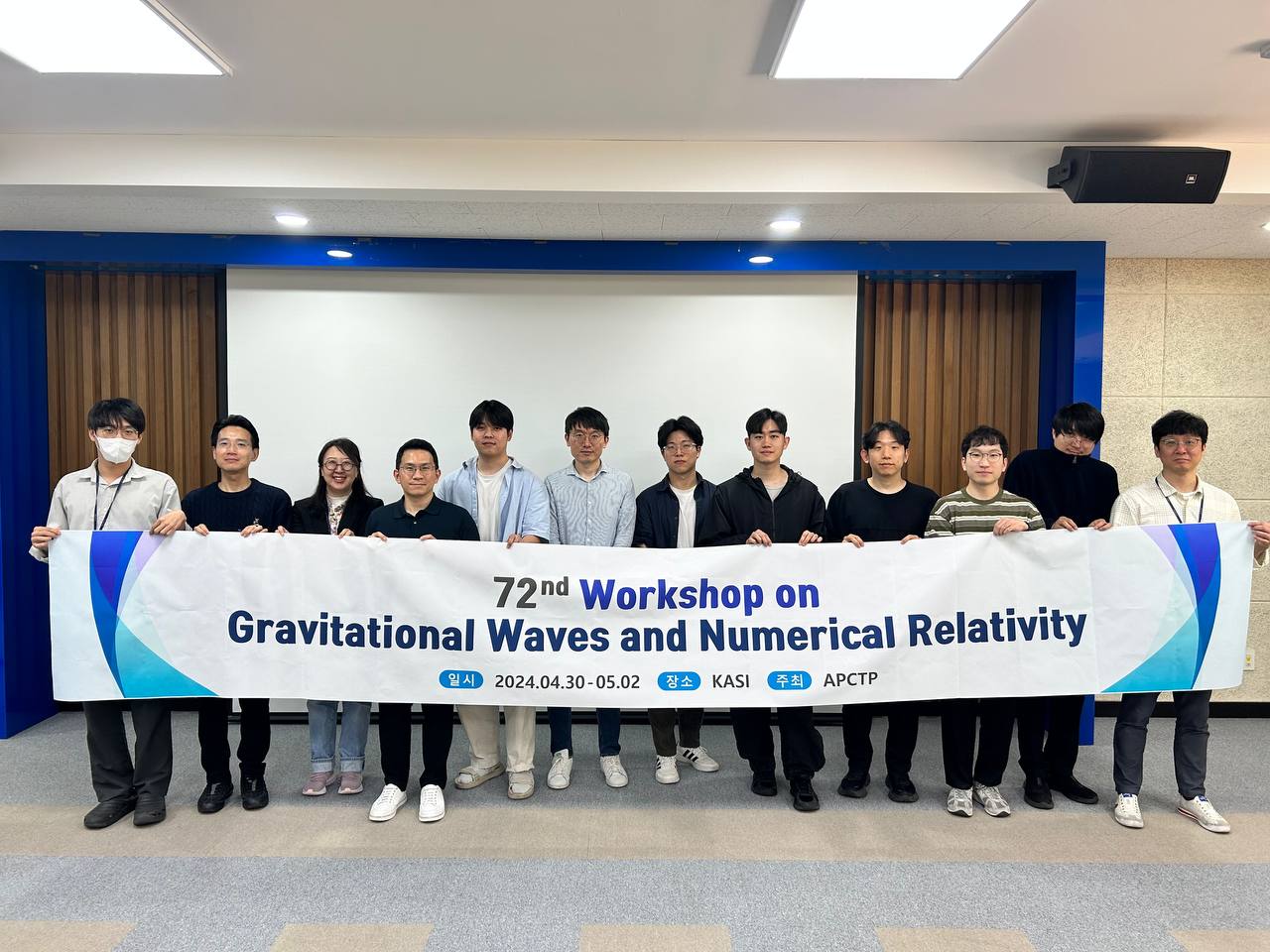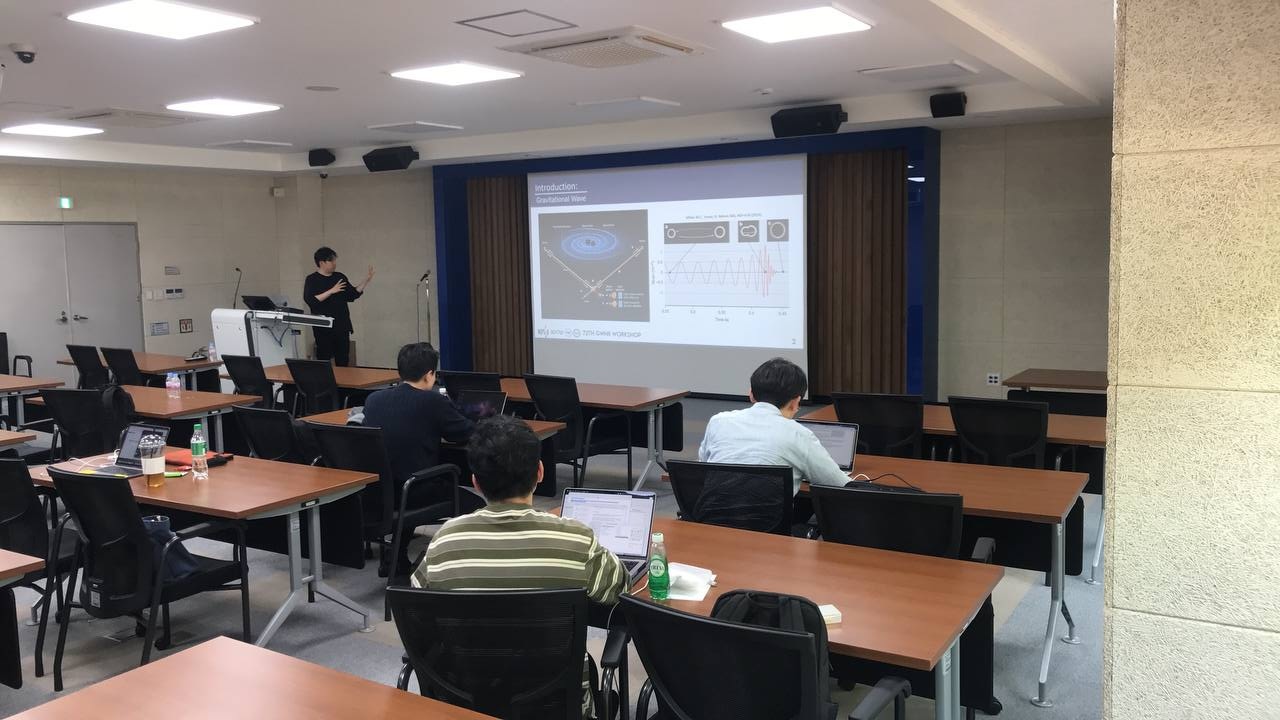Information
- Date: Apr. 30 (Tue.) - May 2 (Thu.), 2024
- Venue: KASI
- Apr. 30: Rm #102 Lee Won Chul Hall
- May 1-2: Rm #331-1 Jang Young Sil Hall
- Audience: Researchers and students in astrophysics
- Number of participants: 15 Offline
- Format: Long and intensive sessions from basic lecture to the latest research with a comfortable atmosphere to ask questions and discuss freely
- Sponsor: APCTP
- Contact
- Jinho Kim (jkim at kasi dot re dot kr)
- Young-Min Kim (ymkim715 at gmail dot com)
Program
- Time Zone: Korea Standard Time (UTC+09:00)
- Apr. 30 (Tue.)
- 14:00 - 14:50 [Student Session 1] Evaluating Seeding Mechanisms for Massive Black Hole Formation at High Redshifts (Seungjae Lee / SNU)
- 15:00 - 17:00 [Main Session 1] A superconducting tensor detector for mid-frequency gravitational waves: its multi-channel nature and main astrophysical targets (Gungwon Kang / Chung-Ang University)
- 17:00 - 18:00 [Discussion]
- 18:00 - [Dinner]
- May 1 (Wed.)
- 10:00 - 12:00 [Main Session 2] Cosmological Insights from Radio Wavelength Observations (Junhan Kim / KAIST)
- 12:00 - 14:00 [Lunch]
- 14:00 - 14:50 [Student Session 2] Mini-Neutron Star Collision on Laptop (Dae Ik Kim / PNU)
- 15:00 - 17:00 [Main Session 3] Gravitational Wave Detection by Microwave Resonant Cavities (Danho Ahn / IBS)
- 17:00 - 18:00 [Discussion]
- 18:00 - [Dinner]
- May 2 (Thu.)
- 10:00 - 12:00 [Main Session 4] Jellyfish galaxies in clusters : Insights from Numerical Simulations (Jaehyun Lee / KASI)
Sessions
- A superconducting tensor detector for mid-frequency gravitational waves: its multi-channel nature and main astrophysical targets
- Speaker: Gungwon Kang (Chung-Ang University)
- Time: Apr. 30 (Tue.) 15:00 - 17:00
- Speaking Language: Korean
- Slide Language: English
- Abstract: Mid-frequency band gravitational-wave detectors will be complementary for the existing Earth-based detectors (sensitive above 10 Hz or so) and the future space-based detectors such as LISA, which will be sensitive below around 10 mHz. A ground-based superconducting omnidirectional gravitational radiation observatory (SOGRO) has recently been proposed along with several design variations for the frequency band of 0.1 to 10 Hz. For two conceptual designs of SOGRO (e.g., SOGRO and aSOGRO), we examine their multi-channel natures, sensitivities and science cases. One of the key characteristics of the SOGRO concept is its six detection channels. The response functions of each channel are calculated for all possible gravitational wave polarizations including scalar and vector modes. Combining these response functions, we also confirm the omnidirectional nature of SOGRO. Hence, even a single SOGRO detector will be able to determine the position of a source and polarizations of gravitational waves, if detected. Taking into account SOGRO’s sensitivity and technical requirements, two main targets are most plausible: gravitational waves from compact binaries and stochastic backgrounds. Based on assumptions we consider in this work, detection rates for intermediate-mass binary black holes (in the mass range of hundreds up to 10^5 M_sun ) are expected to be 0.0065 − 8.1 yr^{−1}. In order to detect stochastic gravitational wave background, multiple detectors are required. Two aSOGRO detector networks may be able to put limits on the stochastic background beyond the indirect limit from cosmological observations.
- Slide File:
- Cosmological Insights from Radio Wavelength Observations
- Speaker: Junhan Kim (KAIST)
- Time: May 1 (Wed.) 10:00 - 12:00
- Speaking Language: English
- Slide Language: English
- Abstract: In the field of observational cosmology, employing a multiwavelength approach is crucial for gaining a thorough understanding of the universe's structure. This presentation will focus on the significant contributions of radio wavelength observations and their associated instruments to cosmological studies. Specifically, I will highlight a selection of projects that explore galaxies and galaxy clusters, illustrating how these observations are instrumental in advancing our knowledge within the field.
- Slide File: Junhan Kim 1
- Slide File: Junhan Kim 2
- Slide File: Junhan Kim 3
- Gravitational Wave Detection by Microwave Resonant Cavities
- Speaker: Danho Ahn (IBS)
- Time: May 1 (Wed.) 15:00 - 17:00
- Speaking Language: Korean
- Slide Language: English
- Abstract: Gravitational wave (GW) detection offers a wealth of observational data crucial for advancing our understanding of astrophysics and cosmology. Previous research has primarily focused on GW detection below kHz such as laser interferometers and pulsar timing arrays. Recent advancements have extended this field into the radio frequency (rf) domain, leveraging experimental techniques developed for axion detection. This presentation will juxtapose gravitational wave detection utilizing microwave resonant cavities with established axion haloscope experiments. Furthermore, I will elaborate on the intricate experimental setups and discuss potential challenges anticipated in the pursuit of gravitational wave detection.
- Slide File: Ahn
- Jellyfish galaxies in clusters : Insights from Numerical Simulations
- Speaker: Jaehyun Lee (KASI)
- Time: May 2 (Thu.) 10:00 - 12:00
- Speaking Language: Korean
- Slide Language: English
- Abstract: Ram pressure stripping is a key environmental effect on galaxies. Jellyfish galaxies provide evidence for the effect of ram pressure in galaxy clusters. We study the formation process of jellyfish galaxies with a multiphase interstellar medium (ISM) using radiation magneto-hydrodynamical simulations. To mimic ram pressure in galaxy clusters, we impose a variety of ram pressure on the simulated galaxies in the form of the intracluster medium (ICM) winds. We find that mild ram pressure effectively strips neutral and molecular hydrogen from the outer disks, while increasing overall star formation activity. On the other hand, strong winds quench disk star formation within 250 Myr with intense disk stripping. We can reproduce evident jellyfish features when strong ram pressure is exerted on a gas-rich galaxy. When the ICM wind is not magnetized, the ISM is stripped from the gas-rich disk, mixing with the ICM, and forming plenty of warm ionized clouds, which can cool and collapse within a few hundred mega-years. In the jellyfish galaxy, stars even form in molecular clumps in its distant tail. In the case of the magnetized ICM winds, the stripped ISM hardly mixes with the ICM due to the suppression of the growth of hydrodynamic instabilities, resulting in remarkably different tail features, compared to the pure hydro case.
- Slide File: Jaehyun Lee 1
- Slide File: Jaehyun Lee 2
- Slide File: Jaehyun Lee 3
- Slide File: Jaehyun Lee 4
- Slide File: Jaehyun Lee 5
- Slide File: Jaehyun Lee 6
- Evaluating Seeding Mechanisms for Massive Black Hole Formation at High Redshifts
- Speaker: Seungjae Lee (SNU)
- Time: Apr. 30 (Tue.) 14:00 - 14:50
- Speaking Language: Korean
- Slide Language: English
- Abstract: The observation of Active Galactic Nuclei (AGNs) at high redshifts (z > 6) has significantly advanced our understanding of the formation and evolution of massive black holes (MBHs). However, explaining the prodigious masses of these early MBHs remains challenging, primarily due to timescale constraints. This study evaluates three predominant seeding mechanisms: remnants of Population III stars, direct collapse black holes, and MBHs formed through runaway collisions. By generating detailed merger histories for dark matter halos and applying an idealized model for halo properties, we introduce initial seed black holes according to the selected seeding scenario. We primarily focus on gas accretion as the main mechanism for MBH growth, while also considering the role of tidal disruption accretion (TDA) in the growth of MBHs originating from runaway collisions. Through statistical analysis, we assess the plausibility of these models in explaining the observed characteristics of high-redshift MBHs. Our findings aim to bridge the gap in our understanding of the early stages of MBH formation and evolution, providing insights into the underlying processes that lead to their massive sizes.
- Slide File: Seungjae Lee
- Mini-Neutron Star Collision on Laptop
- Speaker: Dae Ik Kim (PNU)
- Time: May 1 (Wed.) 14:00 - 14:50
- Speaking Language: Korean
- Slide Language: English
- Abstract: Nuclear physics has provided information on Astrophysics, and vice versa. Especially, Heavy Ion Collisions are expected to give us new constraints on the neutron star equation of state with the advent of rare isotope beam facilities such as FRIB, FAIR and RAON. Transport models are theoretical models that describe the full evolution of Heavy Ion Collision dynamics. Such models enable us to study properties of dense matter produced in heavy ion collisions such as the equation of state. For the experiments that will be performed at RAON, we have developed two transport codes: DaeJeon Boltzmann-Uehling-Uhlenbeck(DJBUU) and Sindong Quantum Molecular Dynamics(SQMD). Each is based on a different framework: Boltzmann-Uehling-Uhlenbeck(BUU) equation and Quantum Molecular Dynamics(QMD), respectively. In this talk, I will describe these models, compare the simulation results, and introduce recent improvements in the DJBUU model.
- Slide File: Dae Ik Kim
Supports
- Accommodation
- If you need accommodation support, select “Full accommodation support is required” in the registration form.
- Meals
- Dinner on Apr. 30
- Breakfsast, Lunch, and Dinner on May 1
- Breakfast on May 2
Registration
- Link: Google Form
- Due
- Accommodation support or reservation is required: Apr. 5 (Fri.)
- No accommodation: Apr. 29 (Mon.)
Photos




